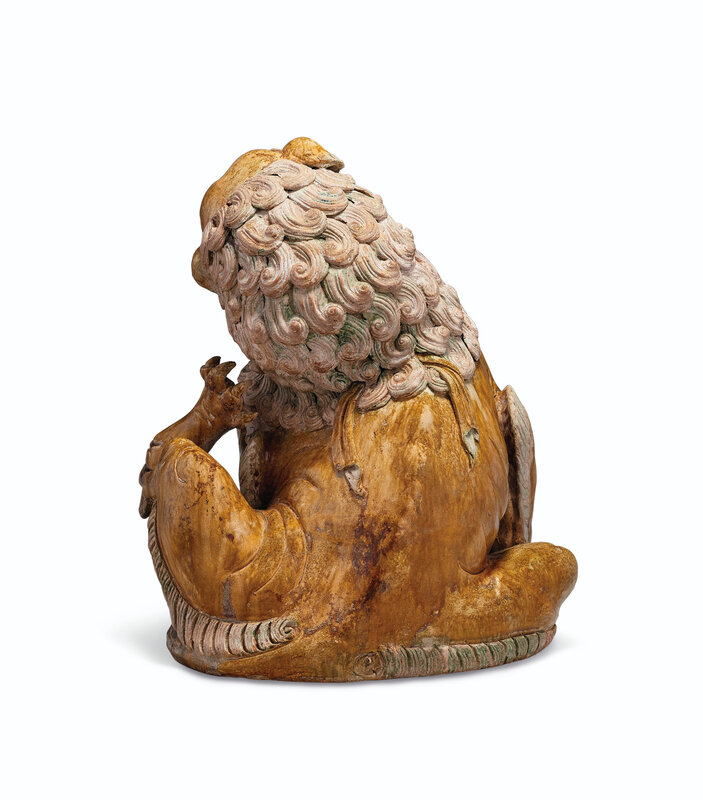A very rare and superbly modeled large amber-glazed pottery figure of a seated lion, Song-Jin dynasty (960-1234)
Lot 847. A very rare and superbly modeled large amber-glazed pottery figure of a seated lion, Song-Jin dynasty (960-1234); 13 in. (28 cm.) high. Estimate 50,000 — 70,000 USD. Price realised USD 75,000. © Christie's Image Ltd 2019.
The powerful, seated lion is shown scratching its head with its left rear paw, and with a ribbon hung with a tassel tied around its broad chest. The body is covered with an amber glaze, the chest with a straw glaze and the curly mane and beard with a now-degraded green glaze.
Note: As in the West, the lion in China was regarded as the king of the beasts, and was a symbol of protection, harmony, blessings and high rank. In their capacity as defenders of the Buddhist law and protector of sacred buildings, lion figures were placed at the entrance to temples, shrines and sometimes private residences. They were usually placed in pairs with the male on the left, female on the right.
The powerfully modeled lion is shown in a dynamic pose, with its left rear paw scratching its ear in a naturalistic and playful manner. A sancai-glazed pottery figure of a lion dating to the Tang dynasty shown in a similar pose, in the Seikado Museum, Tokyo, is illustrated by Masahiko Sato and Gakuji Hasebe (eds.) in Sekai toji zenshu, vol. 11, Tokyo, 1976, p. 87, no. 67. Another Tang-dynasty sancai-glazed pottery lion sold at Christie’s New York, 18 September 2003, lot 217 (Fig. 1), displays another variation of this pose, with its head bent farther to the side and its paw scratching its chin.
Fig. 1. Sancai-glazed pottery fgure of a lion, Tang dynasty (AD 618-907); 8¼in. (21cm.) high. Sold for 147,500 USD at Christie’s New York, Fine Chinese Ceramics and Works of Art, 18 September 2003, lot 217. © Christie's Image Ltd 2003.
Figures of lions shown in this pose remained popular in subsequent periods, as evidenced by the current figure, as well as a Xing ware figure of a lion, dating to the Northern Song dynasty, formerly in the Eumorphopoulos Collection and now in the Victoria & Albert Museum, illustrated by J. Ayers in Far Eastern Ceramics in the Victoria and Albert Museum, London, 1980, fig. 74. (Fig. 2)
Fig. 2. Figure of lion, possibly from the lid of a censer, white porcelain, China, Northern Song dynasty (960-1127). Purchased with Art Fund support, the Vallentin Bequest, Sir Percival David and the Universities China Committee, C.854-1936. © Victoria and Albert Museum, London.
The result of Oxford thermoluminescence test no. C115d58 is consistent with the dating of this lot.
Christie's. Important Chinese Ceramics and Works of Art, New York, 13 September 2019

/https%3A%2F%2Fprofilepics.canalblog.com%2Fprofilepics%2F1%2F0%2F100183.jpg)
/https%3A%2F%2Fstorage.canalblog.com%2F03%2F02%2F119589%2F96711876_o.jpg)
/https%3A%2F%2Fstorage.canalblog.com%2F11%2F31%2F119589%2F94773502_o.jpg)
/https%3A%2F%2Fstorage.canalblog.com%2F20%2F83%2F119589%2F94772815_o.jpg)
/https%3A%2F%2Fstorage.canalblog.com%2F26%2F72%2F119589%2F75604929_o.jpg)
/https%3A%2F%2Fstorage.canalblog.com%2F59%2F60%2F119589%2F26458628_o.jpg)






/http%3A%2F%2Fstorage.canalblog.com%2F51%2F12%2F119589%2F127790655_o.jpg)
/http%3A%2F%2Fstorage.canalblog.com%2F23%2F93%2F119589%2F127790429_o.jpg)
/http%3A%2F%2Fstorage.canalblog.com%2F45%2F43%2F119589%2F127790361_o.jpg)
/http%3A%2F%2Fstorage.canalblog.com%2F28%2F20%2F119589%2F127790302_o.jpg)